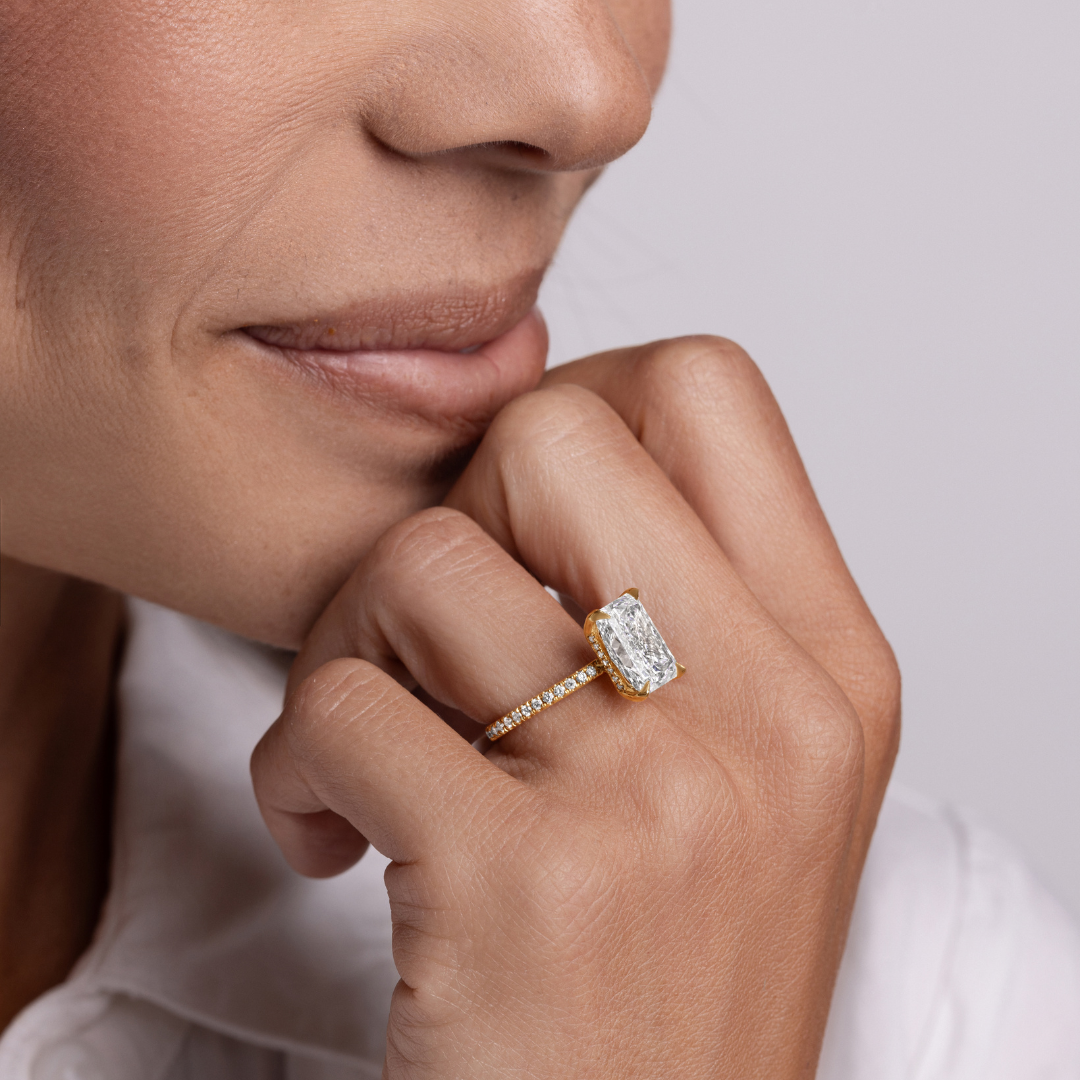Lab grown diamonds have recently garnered attention for being an ethical and affordable alternative to mined diamonds. However, the idea of growing diamonds professionally in a lab is still met with much skepticism.
In this article, we will compare lab grown diamonds with mined ones to determine their credibility. We will also closely inspect their physical and chemical properties and acquired certifications to determine whether they are real and deserving of your attention and money.
What Are Lab Grown Diamonds?
A lab grown or man-made diamond has been produced in a controlled environment using modern technology. Chemical Vapor Deposition (CVD) or High Pressure High Temperature (HPHT) are popular methods that are used to grow these gemstones.
Lab grown diamonds share the same physical and chemical attributes as real diamonds. These types are made from carbon atoms, have similar optical properties, and rank 10 on the Mohs scale. In addition, man-made diamonds are also certified by the Gemological Institute of America (GIA).
Lab Grown Diamonds vs Natural Diamonds - Are They Real?
Since they are grown in an artificial environment, buyers often wonder if lab grown diamonds are real. The answer is yes; lab-cultivated diamonds are just as real as naturally occurring diamonds.
Man-made diamonds have identical color, shape, and clarity grades as that of mined diamonds. Furthermore, they were recognized as real by the Federal Trade Commission in 2018.
While lab grown diamonds are 100% authentic, there are still some minor differences between them and natural diamonds. For starters, natural diamonds contain a tiny amount of nitrogen, whereas man-made diamonds that are grown in a lab, are more pure in nature. Mined diamonds may also have other trace elements encountered during the formation of the gemstone.
However, these differences are not visible to the naked eye and are only noticeable by gemologists using specialized equipment. Put simply, lab grown diamonds have the exact chemical makeup and visual properties as those found within the earth's surface and are equally real.
Lab Grown Diamonds vs Diamond Simulants - What’s the Difference?
Another prevalent misconception about lab grown diamonds is that they are the same as diamond simulants. This statement is entirely false as diamond simulants such as moissanite and cubic zirconia are only engineered to mimic diamonds but are not actually real diamonds.
The chemical makeup of diamond simulants is different from that of natural or lab grown diamonds. They are not composed of true carbon crystals and exhibit distinct properties such as a dull, colorless sparkle in contrast to real diamonds.
Contrary to this, lab grown diamonds, just like mined diamonds, are authentic gemstones. They can be tested based on their thermal conductivity, UV fluorescence, and facet doubling to obtain the same results as natural diamonds.
Are Lab Grown Diamonds Certified?
Another major concern associated with lab grown diamonds is whether they are certified or not. Fortunately enough, lab grown diamonds are graded by recognized institutes such as GIA and IGI that grade mined diamonds as well based on their quality, authenticity, and precision.
The Gemological Institute of America (GIA) uses the same rigorous process to grade both mined and man-made diamonds. It references the GIA clarity, color, and cut grade standards along with information about its growing process (CVD or HPHT) to determine the standard of the synthetic gemstone.
The International Gemological Institute (IGI) also certifies lab grown diamonds on the basis of the 4Cs. However, they mention the words lab grown in the stone’s laser inscription, amongst other details.
The Pros of Lab Grown Diamonds
Having settled the debate about their legitimacy, let’s shine some light on the advantages of investing in lab-created diamonds over that of extracting them from the earth.
Less Expensive
While artificial diamonds are not inexpensive, they are much more competitively priced than mined diamonds. They are sold for prices that are about 30 to 50% less than those of natural diamonds with the same grade and carat weight.
The main reason for this is their growing process. Cultivating diamonds in a lab is much cheaper and faster than the mining process for natural diamonds. This means that artificial diamonds are not only available in abundant quantities but also easily acquired in larger sizes for much cheaper rates.
More Ethical
Diamond mining has an adverse environmental impact and contributes significantly to the carbon footprint. Additionally, mining can involve unethical practices.
Meanwhile, lab diamonds are created in a much more sustainable and ethical manner. This type consumes relatively less water and produces considerably lower carbon emissions than natural diamonds.
The ethical nature of artificial diamonds varies depending on the growing method and transparency of supply chains, but they are generally a more eco-friendly alternative with their responsible waste management system and low emissions of greenhouse gasses.
Better Customizability
Finding naturally occurring colored diamonds is incredibly rare and can cost a fortune. Whereas lab-created diamonds can be found in a variety of colors for many affordable rates.
In addition to being available in remarkable hues like pink, blue, and yellow, synthetic diamonds also offer the option of getting a customized cut and size. These features make lab-cultivated stones ideal for engagement rings and other coveted pieces of jewelry that make you stand out from the crowd.
The Cons of Lab Grown Diamonds
Although lab grown diamonds offer the same sparkle and brilliance as natural diamonds for a cheaper rate, they are also accompanied by certain limitations. Firstly, lab grown diamonds lack the rarity factor and allure of natural diamonds.
Natural diamonds are formed after millions of years and come with unique features. On the other hand, this appeal is lost when such gemstones are produced in mass quantities in a controlled environment such as a lab or a factory.
The future value of man-made diamonds is also a major concern amongst jewelry buyers. Since natural diamonds exist in finite quantities, their value is only expected to go up with time. The same cannot be said about lab grown diamonds.
Another important consideration is that lab grown diamonds hold little to no resale value. One key reason is that they lack scarcity; unlike natural diamonds, which are rare and irreplaceable, lab grown diamonds can be reproduced indefinitely. This abundance in supply impacts their market value, making it unlikely for them to appreciate over time. As a result, consumers looking for an investment in their jewelry often gravitate toward natural diamonds, whose uniqueness and finite availability contribute to a more promising long-term value.
Conclusion
Lab grown diamonds, whether used in bracelets or engagement rings, are equally symbolic as natural diamonds. These artificial diamonds come with an affordable price tag and better customization options to allow you to invest in a special piece of jewelry for your special someone or special occasion.
While lab grown diamonds are 100% authentic, the final decision of choosing between them and mined diamonds lies entirely on you. If you are conscious about the environment, unethical mining practices, or on a tighter budget, lab grown diamonds are perfect for you. But if you prefer the rare allure of natural diamonds and are willing to pay extra to ensure their resale value, natural diamonds are the best fit.
If you are considering purchasing a lab grown or natural mined diamond engagement ring, feel free to browse through our collection at Happy Jewelers. Here, you will find meticulously crafted designs that are remarkable for all sorts of occasions.





Share:
White Gold vs Yellow Gold
Emerald Cut Diamonds: Everything You Need to Know